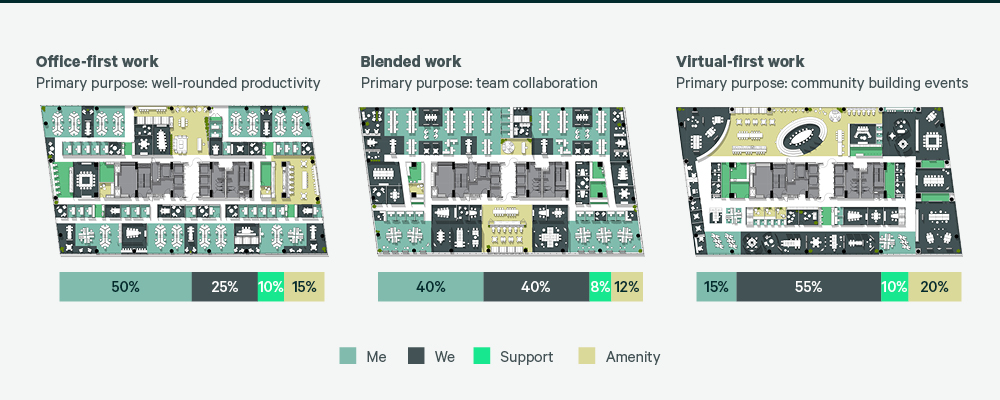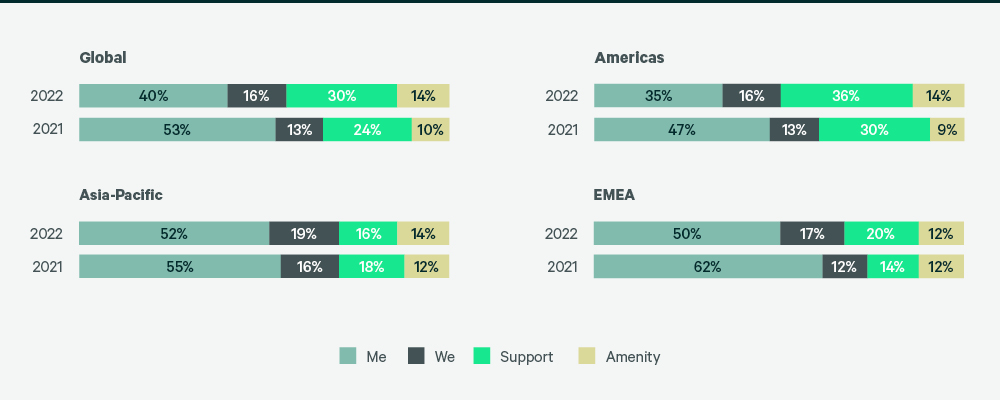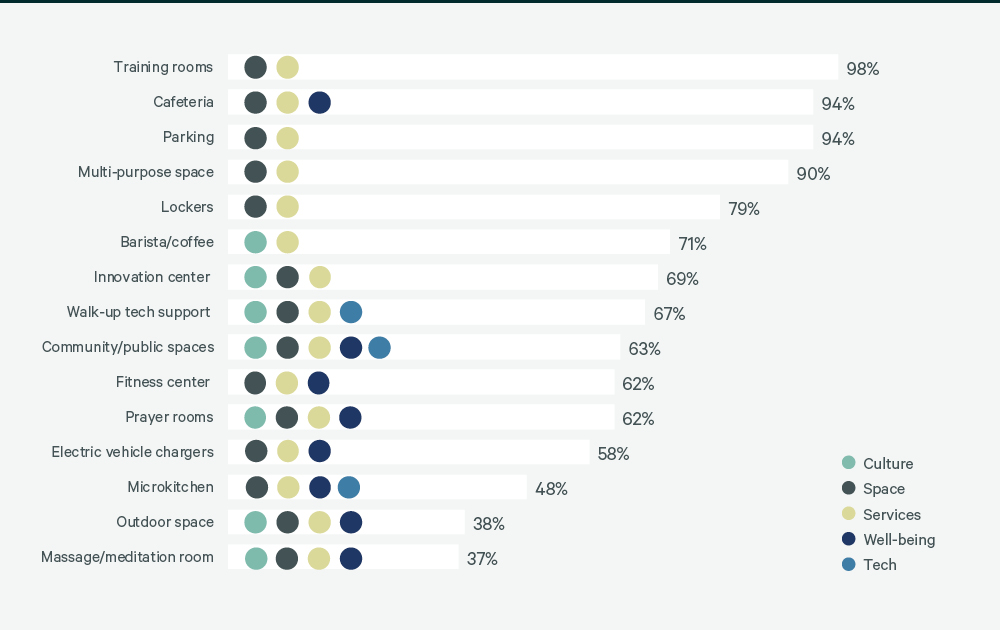Chapter 3
Purpose Driven Flexibility
2022-2023 CBRE Global Workplace & Occupancy Insights
10 Minute Read
Our shared work experience defines our relationship with our organization and our colleagues.

Looking for a PDF Version?
Flexibility shapes the new work experience
Shared work experiences (wx) shape the relationship employees have with their organization and their coworkers.
These experiences are molded by an organization’s culture, its physical workplaces, supporting services and technology, and the health and well-being of its people. With hybrid flexibility now the norm, organizations are rethinking work routines and office layouts to ensure the new work experience can deliver on all fronts.
Figure 2: The new work experience
Source: CBRE Workplace Strategy, October 2022.
Hybrid working preferred worldwide
The last two years have demonstrated that hybrid working is not only possible but preferred by many knowledge workers. For some organizations hybrid working takes an “office-first” approach with most time spent in the office, while others take a “virtual-first” approach, with employees primarily working remotely, using the office for collaboration and on-site work as needed.
Almost 60% of companies have defined criteria for determining hybrid working eligibility. For these organizations, eligibility is largely determined by job function (57%) and manager discretion (45%). Only 21% leave the hybrid working choice up to the employee.
Most organizations take a “guided” approach to hybrid working, offering flexible schedules within a framework so that they know who will be in the office to better predict space needs. This transparency helps ensure employees have productive, collaborative interactions with relevant colleagues when in the office and enables office managers to prepare the right types of space and services as needed.
Figure 3: Workplace policy intentions: Looking ahead, which best describes your workplace policy intentions in a steady state for most of your employees?
Source: CBRE Spring 2022 U.S. Office Occupier Sentiment Survey.
Figure 4: What criteria is used to determine employee eligibility for hybrid working?
Source: CBRE 2022 Occupancy Benchmarking Program.
How flexibility impacts the demand for space
There are three approaches to understanding how hybrid working policies may impact space demand. How these approaches are implemented varies based on the data available and the level of employee flexibility.
FORECASTING DEMAND BASED ON BUSINESS GROWTH
Business units identify how teams will shrink or expand, the number of employees requiring dedicated or shared space, and the time employees will be on site. This approach is best for companies using a guided hybrid program, which tends to have a lower level of variability.
ESTIMATING DEMAND BASED ON BENCHMARKING DATA
Strategists apply a space-sharing ratio to a company’s portfolio based on employee personas—a profile that represent common characteristics of an employees based on their job function and work habits—workplace guidelines and hybrid working policies. This approach is ideal for companies that want to align space programs to employee preferences, and business and cultural objectives, resulting in a moderate level of variability in space demand.
CALCULATING DEMAND BASED ON UTILIZATION PATTERNS
Space demand is measured over time to identify employee patterns and habits. This approach is best for companies providing employees high levels of flexibility as to when they come into the office. This flexibility creates a high level of variability in space demand.
Whatever approach is taken, it’s highly likely that space demands will vary in proportion to the level of flexibility specified in hybrid policies.
Figure 5: How flexibility impacts space needs
Source: CBRE Occupancy Management, October 2022.
Why some organizations don’t support hybrid flexibility
The lack of C-suite support and poor cultural fit are the most common obstacles to supporting hybrid work. Of the 19% of respondents who do not have a hybrid work program, 70% cite poor cultural fit as the primary reason, up from 36% in 2021, and 20% cite lack of C-suite support, down from 21% in 2021. When considering how little job function influenced these decisions (10%), it seems that while most of these organizations could implement hybrid working, they choose not to.
Figure 6: Do you have a hybrid working program?
Source: CBRE 2022 Occupancy Benchmarking Program.
Fundamentally, there has to be a ‘why.’ Only when the C-suite agrees on why employees should be in the office—collaboration, teamwork, connectivity, culture, compliance, mentorship—can the company best strategize on the ‘how.’

The new purpose of the office
Offices are being repositioned to provide tools, spaces and experiences that can't easily be replicated elsewhere. Sixty-nine percent of respondents have revisited their workplace design standards over the course of the pandemic. During that time, over 85% have focused on changes to their open and enclosed collaboration spaces that support connection, which is the primary reason employees are coming to the office.
Figure 7: During the pandemic are you revisiting your current workplace design standards?
Source: CBRE Occupancy Management Pandemic Surveys 2021-2022.
Figure 8: If yes, what are those workplace design standard changes?
Source: CBRE Occupancy Management Pandemic Surveys 2021-2022.
Designing for the new purpose of the office
Workplaces require new planning concepts informed by employee needs and space utilization patterns. These concepts rebalance the allocation of private “me” space and community “we” space to improve flexibility, equitable collaboration for employees working remotely and face-to-face interactions.
When comparing respondents’ existing portfolios with these new planning concepts, there’s a deficit of collaboration space and an excess of support space. A 25% year-over-year reduction in global "me" space indicates more organizations are making material progress in rebalancing portfolios to better support hybrid work.
Figure 9: New workplace design concepts

Source: CBRE 2022 Occupancy Benchmarking Program.
Figure 10: Space composition, 2022 vs. 2021

Source: CBRE 2022 Occupancy Benchmarking Program.
Optimizing sharing ratios
Sharing ratios are a key metric for companies seeking to optimize their portfolios. More than a third of respondents target a sharing ratio above 1.5 to 1. Thirty-one percent of respondents have not specified a target sharing ratio, potentially missing a significant opportunity to optimize their portfolio. Sharing ratios are a critical planning concept that enables hybrid working, cost savings and space consolidation initiatives. Space sharing efficiencies will vary depending on employee preferences and hybrid work strategies. Utilization data can help determine the right sharing ratio based on measurable employee habits and preferences.
Figure 11: Global target sharing ratios, 2022 vs. 2021
Source: CBRE 2022 Occupancy Benchmarking Program.
What is a sharing ratio?
A sharing ratio is the relationship between the number of employees that can share one space over time. For example, a sharing ratio of 1.5 to 1 means a single shared space is needed for every 1.5 employees. Sharing ratios greater than 1 to 1 are used in unassigned seating strategies. This is also known as desk sharing, activity-based working, free address, hot desking or hoteling.

Spaces that attract people to the office
Future workplaces will be designed with collaboration and socialization in mind to match new work styles. To compete with the allure of working from home, occupiers will implement hospitality-inspired experiences in the office.
Figure 12: Which of these specialty spaces or amenities are currently offered at your headquarters (global, regional business unit) facilities

Source: CBRE 2022 Occupancy Benchmarking Program.
The most important amenity in the return to the office is other employees.

Flexibility requires presence awareness
Hybrid work policies mean employees must collaborate in both physical and digital work environments. Presence awareness, or the importance of building transparency and predictability around where and when employees are working, is critical to ensuring meaningful workplace interactions.
To foster presence awareness, consider deploying employee experience apps that leverage existing reservation, occupancy and utilization data. This provides workers a single source for navigating the office, accessing office-based services and connecting to teammates with flexible schedules.
The benefits of employee experience apps
Employee experience apps bring the office to life for hybrid workers. By making workplace information and resources easier to access, they can increase the value of time spent in the office. Benefits include:
ENHANCED WORKPLACE EXPERIENCE
Easily deliver news and information to employees, including articles, building information, content templates and event calendars or registration.
SUPPORTED PRODUCTIVITY
Help employees discover and use the right workplace resources, including room and desk bookings, in-office and campus wayfinding, onsite and local dining information, and service or concierge requests.
DATA-DRIVEN INNOVATION
Use employee experience data and analytics to optimize the workplace, such as discovering which rooms and space types are most and least used.
Integrating the physical and virtual work environments
Hybrid working requires technologies that span physical and virtual environments. Integrating workplace technologies that interact with the built environment and work productivity tools that connect employees is key to creating holistic work experiences that transcend the workplace to enable work from virtually anywhere.
WORKPLACE TOOLS CONNECT PEOPLE WITH SPACE AND SERVICES
To drive meaningful workplace interactions, employees need to know who is present and which spaces and amenities will be available when working on-site. Workplace technology tools help workers find colleagues, reserve work and meeting spaces, and navigate building amenities while in the office.
Workplace technologies that support interaction with the built environment:
- Employee experience apps
- Reservation/booking systems
- Building navigation and wayfinding systems
- Occupancy sensors
- SMART building technologies
PRODUCTIVITY TOOLS DRIVE COLLABORATION AND CONNECTION
Productivity technologies, such as enhanced video conferencing tools and asynchronous communication platforms, connect office-based and remote workers.
Productivity technologies that support employee connection and information sharing:
- Enhanced video conferencing
- Asynchronous communication platforms
- Information management systems
- Process management applications

Authors
Susan Wasmund
Executive Managing Director, Americas Consulting | Global Occupancy Management

Contributors
Related Insights
- Article | Adaptive Spaces
Five Steps Companies Are Taking to Accommodate New Ways of Working
July 5, 2022 6 Minute Read
Explore five global takeaways from CBRE’s Spring 2022 Asia Pacific, EMEA and U.S. Occupier Sentiment Surveys.
- Report | Creating Resilience
10 High-Impact Moves to Reduce Total Cost of Occupancy
September 13, 2022 60 Minute Read
Corporate Real Estate and Facilities leaders face new pressures to decrease spending while improving resilience and accommodating new ways of working.
CBRE Global Research experts share their views on what’s in store for the global economy, office, industrial, retail, multifamily and capital markets for 2022 and beyond.
Related Services
Leverage occupancy data to empower, anticipate and unlock opportunities within your portfolio.
- Plan, Lease & Occupy
Transaction Services
Mitigate risk with a well-defined process and cutting-edge market intelligence.
- Plan, Lease & Occupy
Workplace Consulting
Build resilience, attract and retain talent, and foster connection and collaboration in your workplace.
Insights in Your Inbox
Stay up to date on relevant trends and the latest research.





